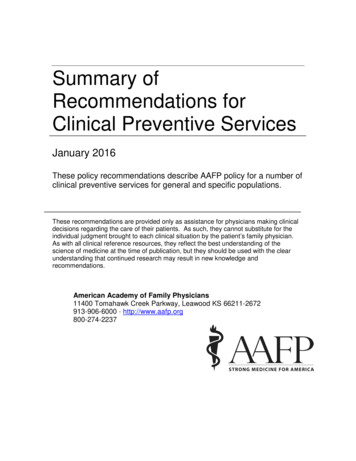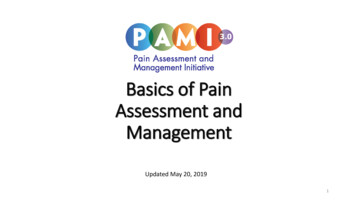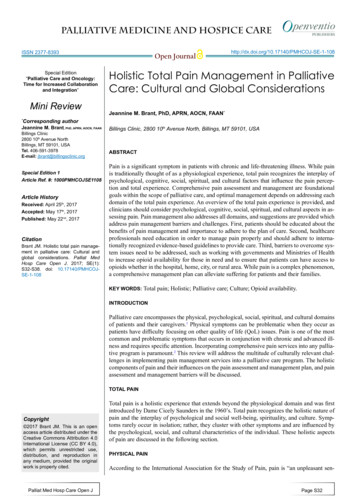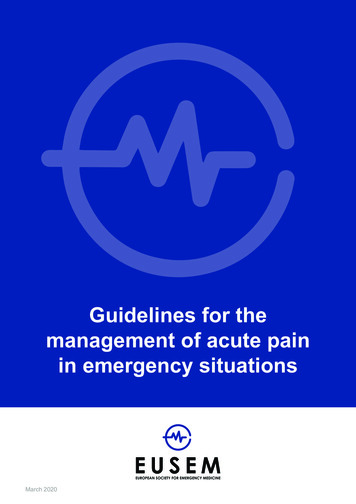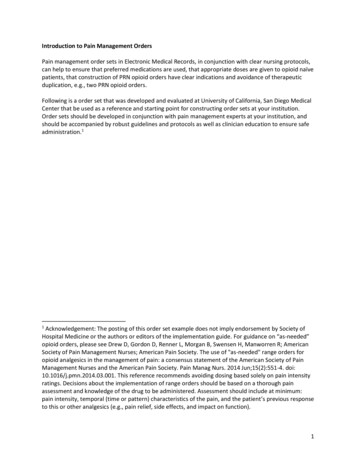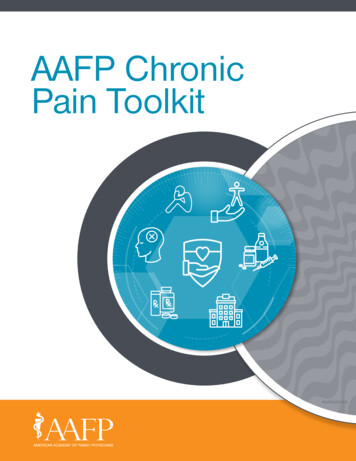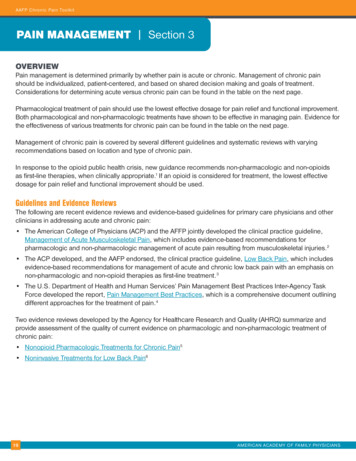
Transcription
AAFP Chronic Pain ToolkitPAIN MANAGEMENT Section 3OVERVIEWPain management is determined primarily by whether pain is acute or chronic. Management of chronic painshould be individualized, patient-centered, and based on shared decision making and goals of treatment.Considerations for determining acute versus chronic pain can be found in the table on the next page.Pharmacological treatment of pain should use the lowest effective dosage for pain relief and functional improvement.Both pharmacological and non-pharmacologic treatments have shown to be effective in managing pain. Evidence forthe effectiveness of various treatments for chronic pain can be found in the table on the next page.Management of chronic pain is covered by several different guidelines and systematic reviews with varyingrecommendations based on location and type of chronic pain.In response to the opioid public health crisis, new guidance recommends non-pharmacologic and non-opioidsas first-line therapies, when clinically appropriate.1 If an opioid is considered for treatment, the lowest effectivedosage for pain relief and functional improvement should be used.Guidelines and Evidence ReviewsThe following are recent evidence reviews and evidence-based guidelines for primary care physicians and otherclinicians in addressing acute and chronic pain: The American College of Physicians (ACP) and the AFFP jointly developed the clinical practice guideline,Management of Acute Musculoskeletal Pain, which includes evidence-based recommendations forpharmacologic and non-pharmacologic management of acute pain resulting from musculoskeletal injuries.2 The ACP developed, and the AAFP endorsed, the clinical practice guideline, Low Back Pain, which includesevidence-based recommendations for management of acute and chronic low back pain with an emphasis onnon-pharmacologic and non-opioid therapies as first-line treatment.3 The U.S. Department of Health and Human Services’ Pain Management Best Practices Inter-Agency TaskForce developed the report, Pain Management Best Practices, which is a comprehensive document outliningdifferent approaches for the treatment of pain.4Two evidence reviews developed by the Agency for Healthcare Research and Quality (AHRQ) summarize andprovide assessment of the quality of current evidence on pharmacologic and non-pharmacologic treatment ofchronic pain: Nonopioid Pharmacologic Treatments for Chronic Pain5 Noninvasive Treatments for Low Back Pain619AMERICAN ACADEMY OF FAMILY PHYSICIANS
AAFP Chronic Pain ToolkitChronic Pain Management ToolsThe table below includes selected tools for chronic pain management in this toolkit, along with links and referenceto additional tools.Chronic Pain Management Tools in ToolkitNameDescriptionLocationTable C. ManagementConsiderations Based on PainType: Acute Versus Chronic PainOverview of background and managementconsiderations for acute versus chronic painJump to table in toolkit.Table D. Chronic PainTreatments OverviewOverview of pharmacologic and non-pharmacologictreatment options for chronic pain with evidencebased indicationsJump to table in toolkit.Chronic Pain Patient HandoutTwo-page patient handout lists chronic paintreatment options and provides information ontreatment goalsJump to tool in toolkit.Additional Chronic Pain Management ToolsPain Self-Management StrategiesSelf-management resource guide for patients withchronic QRI ntary HealthApproaches for Chronic Pain:What the Science SaysCurrent evidence on complementary health products ntary-healthand practices for managing chronic . Dowell D, Haegerich TM, Chou R. CDC guideline for prescribing opioids for chronic pain — United States, 2016. MMWR Recomm Rep. 2016;65(1):1-49.2. American Academy of Family Physicians. Management of acute musculoskeletal pain. Clinical Practice Guideline. Accessed January 8, s/musculoskeletal-pain.html3. American Academy of Family Physicians. Low back pain. Clinical Practice Guideline. Accessed January 8, s/back-pain.html4. Pain Management Best Practices Inter-Agency Task Force. Pain management best practices. U.S. Department of Health and Human Services. AccessedJanuary 8, 2021. ctices-draft-final-report-05062019.pdf5. Agency for Healthcare Research and Quality. Nonopioid pharmacologic treatments for chronic pain. Accessed January 8, fault/files/pdf/nonopioid-chronic-pain.pdf6. Agency for Healthcare Research and Quality. Noninvasive treatments for low back pain. Accessed January 8, fault/files/pdf/back-pain-treatment research.pdf20AMERICAN ACADEMY OF FAMILY PHYSICIANS
AAFP Chronic Pain ToolkitTable C. Management Considerations Based on Pain Type: Acute vs. Chronic Pain21CharacteristicsAcute PainChronic PainDurationNormal healing duration; 3-6 monthsProlonged duration 6 monthsFunctionPhysiologic (protective)Pathologic (non-protective)CauseAcute illness, injury, trauma, surgery or other medicalprocedureInjury, chronic illness, cancer, may have noindefinable pathologyCharacteristicsUsually nociceptive; sharp, localized, sudden/gradualonsetUsually a combination of nociceptive andneuropathic, dull, aching, generalized,persistentTreatment options(non-inclusive list no inany particular order)Nonsteroidal anti-inflammatory drugs (NSAIDS),acetaminophen, opioids, nerve bocks, ketamine, musclerelaxants, pain-reducing modalities (e.g., immobilization,heat/cold, and elevation), graded exercise of the affectedbody area, physical therapy. Opioids are not recommended for acute low back pain.Non-opioid analgesics, physical therapy,cognitive behavioral therapy, rehabilitation,exercise, integrative medical therapies(e.g., yoga, relaxation, tai chi, massage, andacupuncture), opioids on a case-by-case basisGoals of treatmentPain Resolution Resolve underlying cause:- Facilitate recovery- Reduce pain- Minimize side effects- Prevent chronic painPain Control Restore function:- Restore function (physical, emotional, social)- Decrease pain (e.g., treat underlying cause,minimize medication use)- Correct secondary consequences(e.g., maladaptive behavior)
AAFP Chronic Pain ToolkitTreatment Options for Chronic PainThis table outlines different classes of medications and non-pharmacological treatments with indications for use inchronic pain. While pain management is a major issue in the United States, the evidence is still limited, especiallyfor non-pharmacologic treatments. Long-term studies for almost all treatments are lacking. Please note that thistable is provided as an overview and should not be considered as a guideline for specific management.Table D. Pharmacologic TreatmentsClass of MedicationIndicationsaMagnitude of BenefitbPAINFUNCTIONNSAIDs (topical or oral)Low back pain, asteoarthritis, inflammatory arthritis,acute musculoskeletal (MSK) painSmall to noderateNone to smallAcetaminophenAcute MSK painSmallNoneAntidepessantsDiabetic peripheral neuropathy, fibromyalgiaSmallNoneAnticonvulsantsDiabetic peripheral neuropathy, fibromyalgiaSmall to moderateNone (neuropathic pain)Small (fibromyalgia)OpioidsAcute MSK pain, chronic pain, neuropathySmall to no benefitcSmall to no benefitcNon-Pharmacologic TreatmentsTherapyIndicationsaMagnitude of BenefitbPAINFUNCTIONExerciseLow back pain, neck pain, knee and hiposteoarthritis, fibromyalgiaSmall to moderateSmall to moderateCognitive BehavioralTherapyLow back pain, fibromyalgiaSmall to moderateSmall to moderateMassage/Acupuncture/Spinal ManipulationLow back pain, fibromyalgia, chronic headache,neck painSmall to moderateSmall to moderateYoga/Tai ChiLow back pain, fibromyalgiaSmallSmall (fibromyalgia)Moderate (low back pain)a. Summary of treatments and indications pulled from recent guidelines and evidence reviews as outlined above (references 3, 4, 6, 7)b. Magnitude of benefit compared to harms of treatment; will vary based on type/location of painc. Not considered first line treatment for most indications22
AAFP Chronic Pain ToolkitPROMOTING SAFER ANDMORE EFFECTIVE PAIN MANAGEMENTUNDERSTANDING PRESCRIPTION OPIOIDSOpioids are natural or synthetic chemicals that relieve pain bybinding to receptors in your brain or body to reduce the intensityof pain signals reaching the brain. Opioid pain medicationsare sometimes prescribed by doctors to treat pain. Commontypes include: Hydrocodone (e.g., Vicodin) Oxycodone (e.g., OxyContin) Oxymorphone (e.g., Opana), and MorphineAs many as 1 in 4 peoplereceiving prescriptionopioids long term in aprimary care settingstruggles with addiction.1 in 4Opioids can have serious risks including addiction and deathfrom overdose.OPIOIDS AND CHRONIC PAINMany Americans suffer from chronic pain, a major publichealth concern in the United States. Patients with chronicpain deserve safe and effective pain management. At thesame time, our country is in the midst of a prescriptionopioid overdose epidemic. The amount of opioids prescribed and sold in the USquadrupled since 1999, but the overall amount ofpain reported hasn’t changed.Americans engagedin non-medicaluse of opioid painmedication in thelast month. 14.3million1 There is insufficient evidence that prescriptionopioids control chronic pain effectively over the longterm, and there is evidence that other treatments canbe effective with less harm.National Survey on Drug Use and Health (NSDUH), 2014PRESCRIPTION OPIOID OVERDOSE ISAN EPIDEMIC IN THE USLEARN MORE l23AMERICAN ACADEMY OF FAMILY PHYSICIANS
AAFP Chronic Pain ToolkitIMPROVE DOCTOR AND PATIENT COMMUNICATIONThe Centers for Disease Control and Prevention’s (CDC) Guideline forPrescribing Opioids for Chronic Pain provides recommendations to primary caredoctors about the appropriate prescribing of opioid pain medications to improvepain management and patient safety: It helps primary care doctors determine when to start or continue opioidsfor chronic pain It gives guidance about medication dose and duration, and on following upwith patients and discontinuing medication if needed It helps doctors assess the risks and benefits of using opioidsDoctors and patients should talk about: How opioids can reduce pain during short-term use, yet there is not enoughevidence that opioids control chronic pain effectively long term Nonopioid treatments (such as exercise, nonopioid medications, andcognitive behavioral therapy) that can be effective with less harm Importance of regular follow-up Precautions that can be taken to decrease risks including checking drugmonitoring databases, conducting urine drug testing, and prescribingnaloxone if needed to prevent fatal overdose Protecting your family and friends by storing opioids in a secure, lockedlocation and safely disposing unused opioidsGUIDELINE FOR PRESCRIBING OPIOIDSFOR CHRONIC PAINCDC developed the Guideline for Prescribing Opioids forChronic Pain to: Help reduce misuse, abuse, and overdose from opioids Improve communication between primary care doctorsand patients about the risks and benefits of opioidtherapy for chronic painLEARN MORE l24AMERICAN ACADEMY OF FAMILY PHYSICIANS
Duration Normal healing duration; 3-6 months Prolonged duration 6 months Function Physiologic (protective) Pathologic (non-protective) . Opioids are not recommended for acute low back pain .

